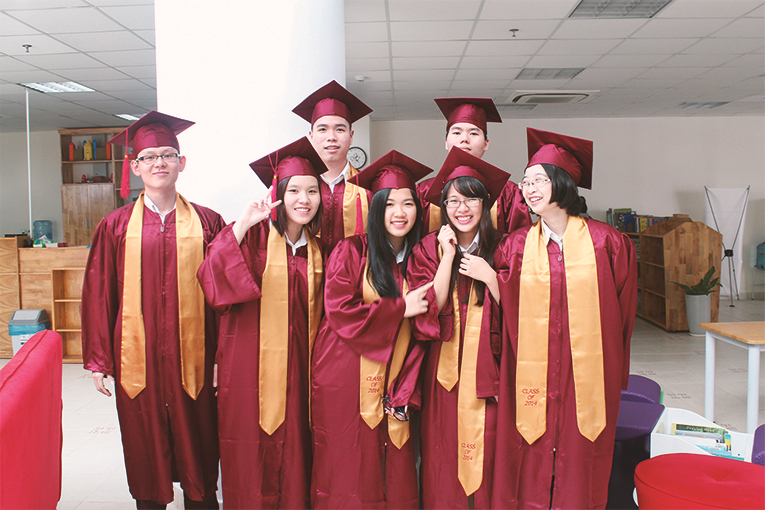
March 13th, 2009: The Canadian International School (CIS) was officially established as the first international school in Vietnam to offer a Canadian curriculum.
2009 – 2010: The school year began at the temporary campus on the ground floor of the Panorama Condominium in Phu My Hung with 165 students.

School year 2012 – 2013: The first generation of students graduated from CISS (Canadian International School System, including BCIS), with proud achievements:
August 4, 2013, CISS Alumni Association (CAA) was established; the first members – the CIS Class of 2013. 4 years after its establishment, CIS began its journey to become an IB World School.

Also in the academic year of 2014 – 2015, BCIS had the first graduation course with 17 excellent students.



The oldest boarding house, Evans House, was built around 1750 as a private house. The headmaster Christopher Hull lived there and took in private boarders. In around 1870, the school numbers dropped to only 9 pupils and headmaster Heppenstall was brought in to transform the school. He believed that the school needed to increase in size dramatically to secure its survival. At that time, the school estate consisted only of the library building and Evans House. Heppenstall commissioned a firm of well-respected architects, Paley and Austin, to design the Victorian Main School buildings and three purpose built boarding houses, School House, Hart and Sedgwick. Heppenstall formed Sedbergh in the model that still exists today. He established the architectural style of the school, introduced rugby team in 1879 and started the Sedberghian magazine in the same year. During this period of change Lupton House was built in the town. The three separate town houses were rented by school initially and then converted to form one character filled building. At first the school boarding houses all had fluid names and would be called by whichever house master was running the house at that time, for example, Sedgwick would be called Mr Oliver’s house. In 1908 the houses were given permanent names in tribute to influential characters from the history of the school.
During the first World War the Masters’ hostel was converted to become Powell House, the sixth house to be formed. Sadly 259 pupils lost their lives in the war. These boys are commemorated on the Memorial Cloisters that were completed in 1922.The monument has five arches to represent the five houses who had suffered casualties. The Cloisters are purposefully of simple design as it was felt that the building should not have needless decoration.
Throughout the twentieth century the school continued to expand. Winder House was established soon after the first World War. Later, the sanatorium was converted to accommodate junior boys under the new title, Cressbrook House. As the junior department swelled in numbers a junior school in its own right was established a short drive away. Girls arrived at Sedbergh in 2001 filling first Lupton House and later Robertson House, the former sanatorium. Following the merger with Casterton School in 2013, a third girls house was opened, Carus house, which is named after the founder of Casterton School.


The Sedbergh Wolf has become a symbol of teamwork, community connection, loyalty, workable competition, drive, passion, and creativity. Why was the image of the wolf chosen as the symbol of Sedbergh School?
Sedbergh School was founded by Mr Roger Lupton, Headmaster of Eton College, Canon of Windsor and chaplain to King Henry VII and Henry VIII. Master Lupton was also a religious advisor to the monarchs during the period the royal family separated from the Roman Catholic church.
Master Lupton was awarded a badge with three wolf heads by King Henry VII. This is also the symbol of the family name Lupton, which comes from the Latin word “lupus” meaning wolf. According to semiotic language, the image of the wolf symbolizes perseverance, courage, and nobility.
In addition, on Lupton’s badge there are other elements such as three lilies symbolizing the Virgin Mary, seashells symbolizing the pilgrimage of Santiago, Compostela, a popular religious pilgrimage throughout Mr. Lupton’s life, and the Tau cross symbolizes the support that Christ gives, as well as mentioning St. Anthony’s Hospital – the hospital that Mr. Lupton owned.

Sedbergh Vietnam – BCIS will give Vietnamese students the opportunity to access the international curriculum of a school with nearly 500 years of history – Sedbergh School in British, to perfect their skills and knowledge. necessary knowledge to help students develop comprehensively in today’s globalized world.
Mr. Peter James Corcoran, General Principal of CISS International School System, said: “The cooperation between BCIS and Sedbergh School will open a new proud journey for BCIS. Students not only inherit the educational quintessence of a school with a 500-year history but also have many more opportunities to study abroad and exchange cultures between Vietnam and the UK. We believe that the harmony in educational philosophy and goals of the two schools will bring the best values to students.”
Mr. Peter Marshall, CEO of Sedbergh School International Limited, shared: “We are honored to partner with BCIS to bring the Sedbergh Vietnam program. We are committed to long-term companionship in implementing comprehensive education and support for students studying in Vietnam or in British.”
Mr. Dan Harrison, Principal of Sedbergh School British, said: “This is an important development step for British education system in Vietnam, opening up new opportunities for Vietnamese students to access world-class academic programs. Sedbergh School has a long history dating back to 1525, central to our educational philosophy is the advice and care of the whole student, with a wide choice of academic and extra-curricular opportunities and a commitment to achieving excellence in every aspect of education. We are ready to support the development of a long-term cooperative relationship with EQuest Education Group throughout Vietnam.”



